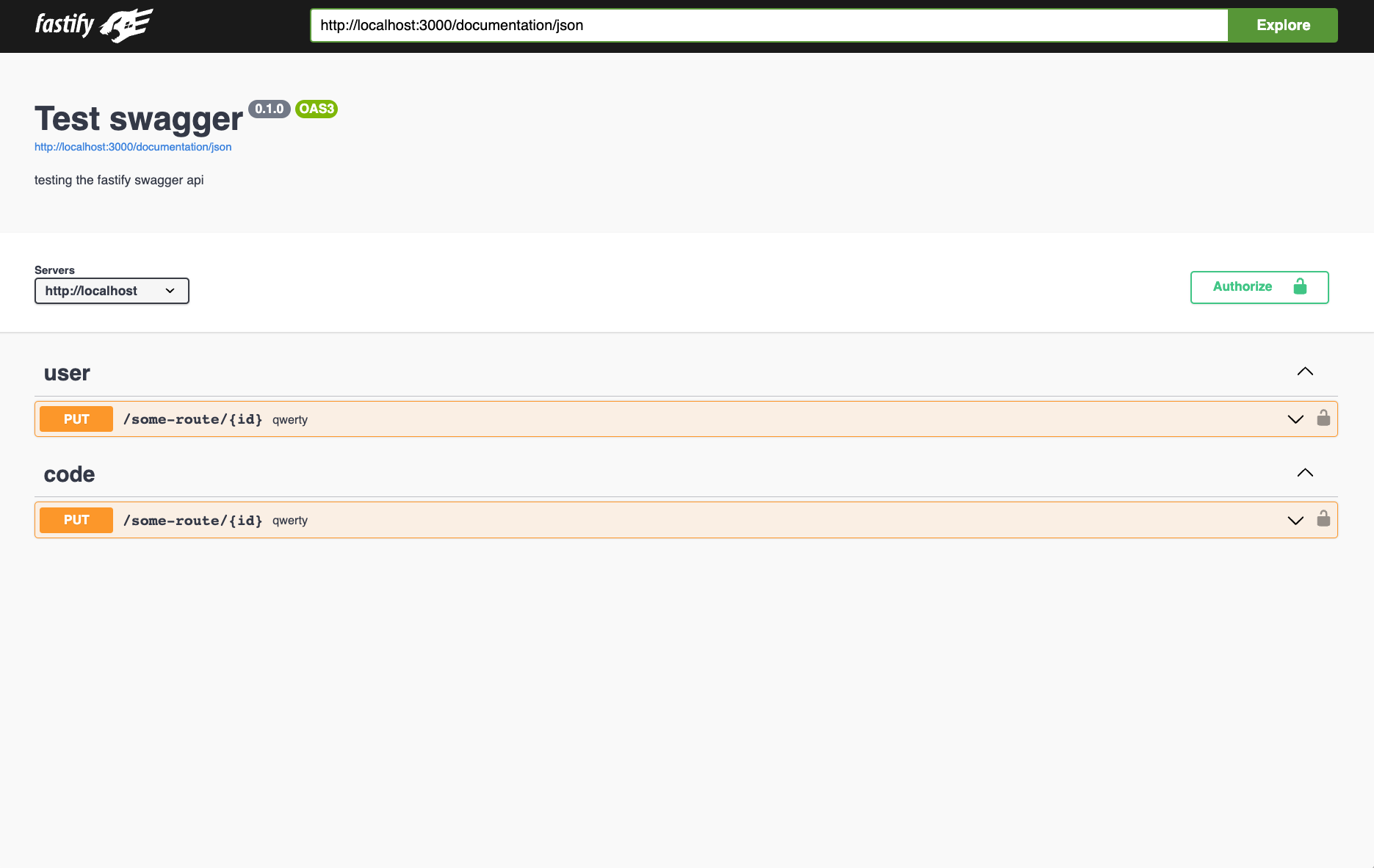@fastify/swagger-ui



A Fastify plugin for serving Swagger UI.
Supports Fastify versions 4.x.

Install
npm i @fastify/swagger-ui
Usage
Add it with @fastify/swagger to your project with register, pass it some options, call the swagger API, and you are done!
const fastify = require('fastify')()
await fastify.register(require('@fastify/swagger'))
await fastify.register(require('@fastify/swagger-ui'), {
routePrefix: '/documentation',
uiConfig: {
docExpansion: 'full',
deepLinking: false
},
uiHooks: {
onRequest: function (request, reply, next) { next() },
preHandler: function (request, reply, next) { next() }
},
staticCSP: true,
transformStaticCSP: (header) => header,
transformSpecification: (swaggerObject, request, reply) => { return swaggerObject },
transformSpecificationClone: true
})
fastify.put('/some-route/:id', {
schema: {
description: 'post some data',
tags: ['user', 'code'],
summary: 'qwerty',
params: {
type: 'object',
properties: {
id: {
type: 'string',
description: 'user id'
}
}
},
body: {
type: 'object',
properties: {
hello: { type: 'string' },
obj: {
type: 'object',
properties: {
some: { type: 'string' }
}
}
}
},
response: {
201: {
description: 'Successful response',
type: 'object',
properties: {
hello: { type: 'string' }
}
},
default: {
description: 'Default response',
type: 'object',
properties: {
foo: { type: 'string' }
}
}
},
security: [
{
"apiKey": []
}
]
}
}, (req, reply) => {})
await fastify.ready()
API
Register options
Options
| Option | Default | Description |
|---|
| baseDir | undefined | Specify the directory where all spec files that are included in the main one using $ref will be located. By default, this is the directory where the main spec file is located. Provided value should be an absolute path without trailing slash. |
| initOAuth | {} | Configuration options for Swagger UI initOAuth. |
| routePrefix | '/documentation' | Overwrite the default Swagger UI route prefix. |
| staticCSP | false | Enable CSP header for static resources. |
| transformStaticCSP | undefined | Synchronous function to transform CSP header for static resources if the header has been previously set. |
| transformSpecification | undefined | Synchronous function to transform the swagger document. |
| transformSpecificationClone | true | Provide a deepcloned swaggerObject to transformSpecification |
| uiConfig | {} | Configuration options for Swagger UI. |
| uiHooks | {} | Additional hooks for the documentation's routes. You can provide the onRequest and preHandler hooks with the same route's options interface. |
| theme | {} | Add custom JavaScript and CSS to the Swagger UI web page |
| logLevel | info | Allow to define route log level. |
The plugin will expose the documentation with the following APIs:
| URL | Description |
|---|
'/documentation/json' | The JSON object representing the API |
'/documentation/yaml' | The YAML object representing the API |
'/documentation/' | The swagger UI |
'/documentation/*' | External files that you may use in $ref |
uiConfig
To configure Swagger UI, you need to modify the uiConfig option.
It's important to ensure that functions are self-contained. Keep in mind that
you cannot modify the backend code within the uiConfig functions, as these
functions are processed only by the browser. You can reference the Swagger UI
element using ui, which is assigned to window.ui.
Example
const fastify = require('fastify')()
await fastify.register(require('@fastify/swagger'))
await fastify.register(require('@fastify/swagger-ui'), {
uiConfig: {
onComplete: function () {
alert('ui has type of ' + typeof ui)
alert('fastify has type of ' + typeof fastify)
alert('window has type of ' + typeof window)
alert('global has type of ' + typeof global)
}
}
})
transformSpecification
There can be use cases, where you want to modify the swagger definition on request. E.g. you want to modify the server
definition based on the hostname of the request object. In such a case you can utilize the transformSpecification-option.
Example
const fastify = require('fastify')()
await fastify.register(require('@fastify/swagger'))
await fastify.register(require('@fastify/swagger-ui'), {
transformSpecification: (swaggerObject, req, reply) => {
swaggerObject.host = req.hostname
return swaggerObject
}
})
By default fastify.swagger() will be deepcloned and passed to the transformSpecification-function, as fastify.swagger()
returns a mutatable Object. You can disable the deepcloning by setting transformSpecificationClone to false. This is useful,
if you want to handle the deepcloning in the transformSpecification function.
Example with caching
const fastify = require('fastify')()
const LRU = require('tiny-lru').lru
const rfdc = require('rfdc')()
await fastify.register(require('@fastify/swagger'))
const swaggerLru = new LRU(1000)
await fastify.register(require('@fastify/swagger-ui'), {
transformSpecificationClone: false,
transformSpecification: (swaggerObject, req, reply) => {
if (swaggerLru.has(req.hostname)) {
return swaggerLru.get(req.hostname)
}
const clonedSwaggerObject = rfdc(swaggerObject)
clonedSwaggerObject.host = req.hostname
swaggerLru.set(req.hostname, clonedSwaggerObject)
return clonedSwaggerObject
}
})
theme
You can add custom JavaScript and CSS to the Swagger UI web page by using the theme option.
Example
const fastify = require('fastify')()
fastify.register(require('@fastify/swagger'))
await fastify.register(require('@fastify/swagger-ui'), {
theme: {
title: 'My custom title',
js: [
{ filename: 'special.js', content: 'alert("client javascript")' }
],
css: [
{ filename: 'theme.css', content: '* { border: 1px red solid; }' }
],
favicon: [
{
filename: 'favicon.png',
rel: 'icon',
sizes: '16x16',
type: 'image/png',
content: Buffer.from('iVBOR...', 'base64')
}
]
}
})
You can add custom JavaScript and CSS to the Swagger UI web page by using the theme option.
logo
It's possible to override the logo displayed in the top bar by specifying:
await fastify.register(require('@fastify/swagger-ui'), {
logo: {
type: 'image/png',
content: Buffer.from('iVBOR...', 'base64')
},
theme: {
favicon: [
{
filename: 'favicon.png',
rel: 'icon',
sizes: '16x16',
type: 'image/png',
content: Buffer.from('iVBOR...', 'base64')
}
]
}
})
Protect your documentation routes
You can protect your documentation by configuring an authentication hook.
Here is an example using the @fastify/basic-auth plugin:
Example
const fastify = require('fastify')()
const crypto = require('node:crypto')
fastify.register(require('@fastify/swagger'))
function compare (a, b) {
a = Buffer.from(a)
b = Buffer.from(b)
if (a.length !== b.length) {
crypto.timingSafeEqual(a, a)
return false
}
return crypto.timingSafeEqual(a, b)
}
await fastify.register(require('@fastify/basic-auth'), {
validate (username, password, req, reply, done) {
let result = true
result = compare(username, validUsername) && result
result = compare(password, validPassword) && result
if (result) {
done()
} else {
done(new Error('Access denied'))
}
},
authenticate: true
})
await fastify.register(require('@fastify/swagger-ui', {
uiHooks: {
onRequest: fastify.basicAuth
}
})
License
Licensed under MIT.






